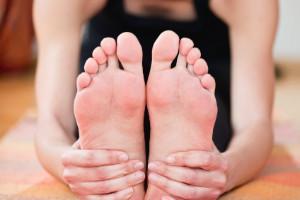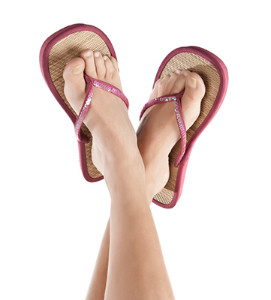Connect With Us
Blog
Items filtered by date: June 2017
Avoiding Plantar Fasciitis
 Plantar fasciitis is a common foot condition that may cause a stabbing pain in the heel. As a result, someone who has the condition may find common activities such as running and walking to be extremely painful. Plantar fasciitis occurs when there is an injury of the plantar fascia--the long structure at the base of the foot that connects the heel to the toes. Stretching has been proven to be effective in alleviating pain related to plantar fasciitis, so it is important that those with the condition incorporate stretching into their daily routines.
Plantar fasciitis is a common foot condition that may cause a stabbing pain in the heel. As a result, someone who has the condition may find common activities such as running and walking to be extremely painful. Plantar fasciitis occurs when there is an injury of the plantar fascia--the long structure at the base of the foot that connects the heel to the toes. Stretching has been proven to be effective in alleviating pain related to plantar fasciitis, so it is important that those with the condition incorporate stretching into their daily routines.
Plantar fasciitis can be very painful and inconvenient. If you are experiencing heel pain or symptoms of plantar fasciitis, contact Imaze Marian Davis, DPM from Marian Davis, DPM, PA. Our doctors can provide the care you need to keep you pain-free and on your feet.
What Is Plantar Fasciitis?
Plantar fasciitis is the inflammation of the thick band of tissue that runs along the bottom of your foot, known as the plantar fascia, and causes mild to severe heel pain.
What Causes Plantar Fasciitis?
- Excessive running
- Non-supportive shoes
- Overpronation
- Repeated stretching and tearing of the plantar fascia
How Can It Be Treated?
- Conservative measures – anti-inflammatories, ice packs, stretching exercises, physical therapy, orthotic devices
- Shockwave therapy – sound waves are sent to the affected area to facilitate healing and are usually used for chronic cases of plantar fasciitis
- Surgery – usually only used as a last resort when all else fails. The plantar fascia can be surgically detached from the heel
While very treatable, plantar fasciitis is definitely not something that should be ignored. Especially in severe cases, speaking to your doctor right away is highly recommended to avoid complications and severe heel pain. Your podiatrist can work with you to provide the appropriate treatment options tailored to your condition.
If you have any questions please feel free to contact our office located in Miami, FL . We offer the newest diagnostic and treatment technologies for all your foot and ankle needs.
How Wearing Flip-Flops May Cause Plantar Fasciitis
 Plantar fasciitis is a common condition that tends to appear during the summer months, and flip-flops could be one of the reasons this happens. Flip-flops offer no support for the feet, which causes the plantar fascia to stretch unnaturally; this may lead to heel pain. Wearing flip-flops also causes you to scrunch your toes in order to grip the thong of the sandal, causing you to shorten your stride. As a result, you may experience hammertoes, muscle pain, and shin splits from forcing your legs to work harder.
Plantar fasciitis is a common condition that tends to appear during the summer months, and flip-flops could be one of the reasons this happens. Flip-flops offer no support for the feet, which causes the plantar fascia to stretch unnaturally; this may lead to heel pain. Wearing flip-flops also causes you to scrunch your toes in order to grip the thong of the sandal, causing you to shorten your stride. As a result, you may experience hammertoes, muscle pain, and shin splits from forcing your legs to work harder.
Flip-flops are not always the best choice of footwear. If you have any concerns about your feet or ankles, contact Imaze Marian Davis, DPM from Marian Davis, DPM, PA. Our doctors will assist you with all of your foot and ankle needs.
Flip-Flops and Feet
When the weather starts warming up, people enjoy wearing flip-flops. Flip-flops are comfortable, stylish, and easy to slip on and off; they're perfect for any summer beach goer. However, these shoes can cause harm to the feet.
How Can Flip-Flops Affect Me Long-Term?
- Ankle problems
- Hip problems
- Lower back problems
- Pain in the balls of the feet
- Problems with foot arches
- Changes in the way you walk
Are There Injuries Associated with Flip-Flops?
Yes. Since flip-flops are relatively weak and do not provide the same amount of support as sneakers, people who wear flip-flops regularly are more susceptible to injuries. On top of that, the open nature of the shoe makes your feet more prone to other problems, such as cuts and even infections. Common injuries and ailments include:
- Sprained ankles
- Blisters
- Infections
- Cuts and Scrapes
I like Wearing Flip-Flops. Are There Safe Alternatives?
When buying flip-flops, try to find ones that have sturdy soles and that are made of high-quality materials that will support for your feet. These flip-flops will cost more but will also last longer as a result.
If you have any questions please feel free to contact our office located in Miami, FL . We offer the newest diagnostic and treatment technologies for all your foot and ankle needs.
Mariner’s Jean Segura Suffers Ankle Sprain
 Jean Segura of the Seattle Mariners recently sprained his ankle in a game against the Rockies. The shortstop said that “It was feeling really bad the first day,” and that he’s been feeling “much better” in the days following the injury. He suffered the ankle injury during the fourth inning as he slid into second base attempting to advance on a sac fly. Segura who batted .341 so far this season with an OPS of .391 has been called “impossible” to replace by minor leaguer Tyler Smith. His presence will surely be missed by the Mariners and Segura is eager to begin rehab so he can rejoin the team as soon as possible.
Jean Segura of the Seattle Mariners recently sprained his ankle in a game against the Rockies. The shortstop said that “It was feeling really bad the first day,” and that he’s been feeling “much better” in the days following the injury. He suffered the ankle injury during the fourth inning as he slid into second base attempting to advance on a sac fly. Segura who batted .341 so far this season with an OPS of .391 has been called “impossible” to replace by minor leaguer Tyler Smith. His presence will surely be missed by the Mariners and Segura is eager to begin rehab so he can rejoin the team as soon as possible.
Ankle sprains are common but need immediate attention. If you need your feet checked, contact Imaze Marian Davis, DPM from Marian Davis, DPM, PA. Our doctors can provide the care you need to keep you pain-free and on your feet.
How Does an Ankle Sprain Occur?
Ankle sprains take place when the ligaments in your ankle are torn or stretched beyond their limits. There are multiple ways that the ankle can become injured, including twisting or rolling over onto your ankle, putting undue stress on it, or causing trauma to the ankle itself.
What Are the Symptoms?
- Mild to moderate bruising
- Limited mobility
- Swelling
- Discoloration of the skin (depending on severity)
Preventing a Sprain
- Wearing appropriate shoes for the occasion
- Stretching before exercises and sports
- Knowing your limits
Treatment of a Sprain
Treatment of a sprain depends on the severity. Many times, people are told to rest and remain off their feet completely, while others are given an air cast. If the sprain is very severe, surgery may be required.
If you have suffered an ankle sprain previously, you may want to consider additional support such as a brace and regular exercises to strengthen the ankle.
If you have any questions please feel free to contact our office located in Miami, FL . We offer the newest diagnostic and treatment technologies for all your foot and ankle needs.
Tips for Finding Your Perfect Shoe
 The first step to getting into a proper running routine is to make sure you are wearing the right running shoes. The proper shoe will help to correct biomechanical issues and prevent injury. You should always go to a sneaker store that specializes in running shoes so that the workers can help you find a sneaker that fits your foot strike. There are three main types of runners based on foot strikes: overpronators (when the foot rolls inward too much), neutral pronators (feet roll inward slightly), and supinators (feet don’t roll inward enough). Certain running shoe stores will have you run on a treadmill so that the workers can best determine which shoe type will fit you properly. You will know the shoe is a good fit if you “feel like you want to go run immediately," said runner Dimity McDowell.
The first step to getting into a proper running routine is to make sure you are wearing the right running shoes. The proper shoe will help to correct biomechanical issues and prevent injury. You should always go to a sneaker store that specializes in running shoes so that the workers can help you find a sneaker that fits your foot strike. There are three main types of runners based on foot strikes: overpronators (when the foot rolls inward too much), neutral pronators (feet roll inward slightly), and supinators (feet don’t roll inward enough). Certain running shoe stores will have you run on a treadmill so that the workers can best determine which shoe type will fit you properly. You will know the shoe is a good fit if you “feel like you want to go run immediately," said runner Dimity McDowell.
If you are a runner, wearing the right running shoe is essential. For more information, contact Imaze Marian Davis, DPM from Marian Davis, DPM, PA. Our doctors can provide the care you need to keep you pain-free and on your feet.
Choosing the Right Running Shoe for Your Foot Type
To increase performance and avoid the risk of injury, it is important to choose the right running shoe based on your foot type. The general design of running shoes revolves around pronation, which is how the ankle rolls from outside to inside when the foot strikes the ground.
- Neutral runners are able to choose from a wide variety of shoes, including minimalist shoes or even going barefoot.
- Runners who overpronate, or experience an over-abundance of ankle rolling, should choose shoes that provide extra motion control and stability.
- Runners who underpronate, or supinate, have feet that have high arches and lack flexibility, preventing shock absorption. They require shoes with more flexibility and cushion.
If you have any questions please feel free to contact our office located in Miami, FL . We offer the newest diagnostic and treatment technologies for all your foot and ankle needs.


